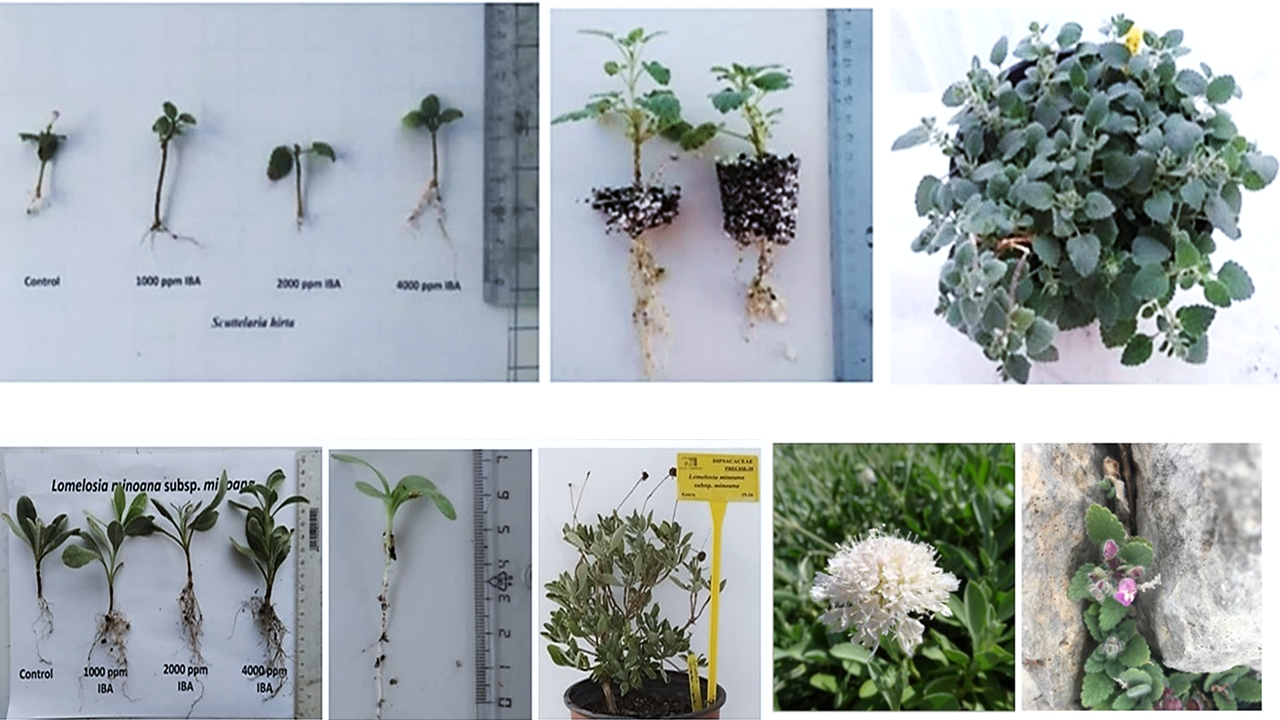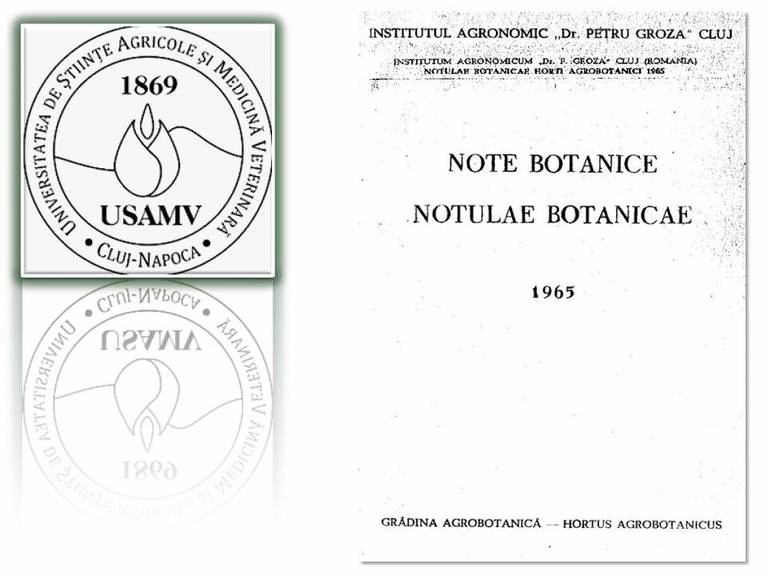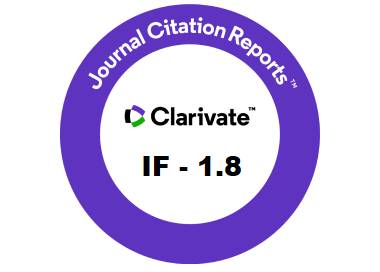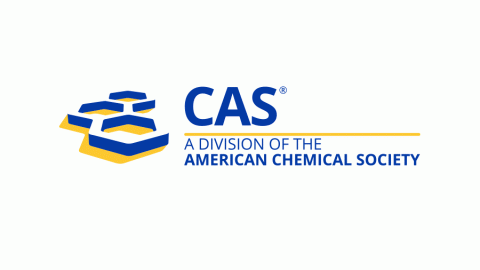Propagation and ex-situ conservation of Lomelosia minoana subsp. minoana and Scutellaria hirta - two ornamental and medicinal Cretan endemics (Greece)
DOI:
https://doi.org/10.15835/nbha49112168Keywords:
cuttings; floriculture; germplasm preservation; phytogenetic resources; rooting; seed germination; sustainable utilizationAbstract
Human needs and concomitant commercial trade to date trigger the demand of new ornamental plants and new natural medicinal products. The current study includes preliminary seed germination trials and presents the development of effective vegetative propagation protocols for Lomelosia minoana subsp. minoana (Dipsacaceae) and Scutellaria hirta (Lamiaceae), both globally rare, local endemics of Crete (Greece) with potential ornamental and medicinal value. Based on material collected directly from the wild, seed germination was succeeded (38%, T50: 10.74) only for L. minoana subsp. minoana. The optimal indole-3-butyric acid concentrations for effective rooting of cuttings were 2000 mg L-1 for L. minoana subsp. minoana (85%) and 4000 mg L-1 for S. hirta (50%). Seasonal differences were observed in respective rooting rates of the studied taxa. The detected rooting rates for L. minoana subsp. minoana cuttings are above standards to allow possible commercial application in the ornamental industry. Although the detected rooting rate (50%) for S. hirta was adequate for its ex situ conservation, it seems almost marginal for future commercial application and further investigation is needed. The sustainable utilization of these Cretan endemics studied herein provides new input for the ornamental-horticultural and cosmetic-pharmaceutical industries. This study shows how rare and endemic wild plant species can be progressively domesticated and introduced into sustainable cultivation systems in order to avoid the depletion of unique phytogenetic resources.
References
Ahern J (2013). Urban landscape sustainability and resilience: the promise and challenges of integrating ecology with urban planning and design. Landscape Ecology 28:1203-1212. https://doi.org/10.1007/s10980-012-9799-z
Antrop M (2006). Sustainable landscapes: contradiction, fiction or utopia? Landscape and Urban Planning 75:187-197. https://doi.org/10.1016/j.landurbplan.2005.02.014
Barth JG (2020). Limestone and calcium in plants. At: Soin de la Terre. Retrieved 2020 May 11 from https://www.soin-de-la-terre.org
Beck T (2013). Principles of ecological landscape design. Island Press, Washington DC pp 107-124.
Beemnet MK, Solomon AM (2012). Effect of cutting position and rooting hormone on propagation ability of stevia (Stevia rebaudiana Bertoni). The African Journal of Plant Science and Biotechnology 6:5-8.
Beisheim K, Otte A (2017). Evaluating the ornamental value of the Caucasian flora in Georgia. Tuexenia 37:33-354. https://doi.org/10.14471/2017.37.008
Bewley JD, Black M (1994). Seeds: Physiology of development and germination. Plenum Press (4th ed), New York, pp 420.
Calhoun S (2012). Designer plant combinations: 105 Stunning gardens using six plants or fewer. Storey Publishing, USA, pp 240.
Cantor M, Erzsebet B, Zaharia A (2009). Scutellaria genus – possibilities for use of species as floral and medicinal crop. Journal of Plant Development 16:55-59.
Cerabolini B, Ceriani RM, Caccianiga M, De Andreis R, Raimondi B (2003). Seed size, shape and persistence in soil: a test on Italian flora from Alps to Mediterranean coasts. Seed Science Research 13:75-85. DOI: https://doi.org/10.1079/SSR2002126
Christopoulou C, Graikou K, Chinou I (2008). Chemosystematic value of chemical constituents from Scabiosa hymettia (Dipsacaceae). Chemistry & Biodiversity 5:318-323. https://doi.org/10.1002/cbdv.200890029
Cole IB, Farooq FT, Murch SJ (2009). Protocols for establishment of an in vitro collection of medicinal plants in the genus Scutellaria. Methods in Molecular Biology 547:155-165. https://doi.org/10.1007/978-1-60327-287-2_13
Cole IB, Saxena PK, Murch SJ (2007). Medicinal biotechnology in the genus Scutellaria. In Vitro Cellular and Developmental Biology - Plant 43(4):318-327. https://doi.org/10.1007/s11627-007-9055-4
Cristaudo A, Catara S, Impelluso C (2015). Conservation of native germplasm of the Mediterranean Region: ecological characterization of Sicilian flora species for sustainable use. In: Mariotti M, Magrini S (Eds). Conservation of threatened species: activities and collaborations within the network. RIBES Series 1, RIBES, pp 53-56.
Csonthos P, Tamas J, Balogh L (2007). Thousand-seed weight records of species from the flora of Hungary, II. Dicotyledonopsida. Studia Botatina Hungarica 38:179-189.
Cui XH, Chakrabarty D, Lee EJ, Paek KY (2010). Production of adventitious roots and secondary metabolites by Hypericum L. in a bioreactor. Bioresource Technology 101(12):4708-4716. https://doi.org/10.1016/j.biortech.2010.01.115
De Almeida MR, Aumond JRM, Da Costa CT, Schwambach J, Ruedell CM, Correa LR, … Fett-Neto AG (2017). Environmental control of adventitious rooting in Eucalyptus and Populus cuttings. Trees 31:1377-1390. https://doi.org/10.1007/s00468-017-1550-6
Dee LE., Cowles J, Isbell F, Pau S, Gaines SD, Reich PB (2019). When do ecosystem services depend on rare species? Trends in Ecology & Evolution 34(8):746-758. https://doi.org/10.1016/j.tree.2019.03.010
Denaxa NK, Vemmos SN, Roussos PA (2012). The role of endogenous carbohydrates and seasonal variation in rooting ability of cuttings of an easy and a hard to root olive cultivars (Olea europaea L.). Scientia Horticulturae 143:19-28. https://doi.org/10.1016/j.scienta.2012.05.026
Elhaak MA, Matter MZ, Zayed MA, Gad DA (2015). Propagation principles in using indole-3-butyric acid for rooting rosemary (Rosmarinus officinalis) stem cuttings. Journal of Horticulture 2:1. https://doi.org/10.4172/2376-0354.1000121
Ferreira BGA, Zuffellato-Ribas KC, Wendling I, Koehler HS, Nogueira AC (2010). Miniestaquia de Sapium glandulatum (Vell.) Pax com o uso de ácido indol butírico e ácido naftaleno acético [Mini-cuttings of Sapium glandulatum (Vell.) Pax using indole butyric acid and naphthalene acetic acid]. Ciência Florestal 20(1):19-31. https://doi.org/10.5902/198050981758
Frischie S, Fernandez-Pascual E, Ramirez CG, Toorop P, Gonzalez MH, Jimenez-Alfaro B (2018). Hydrothermal thresholds for seed germination in winter annual forbs from old-field Mediterranean landscapes. Plant Biology 21(3):449-457. https://doi.org/10.1111/plb.12848
Genmedoc (2006). Μέθοδοι Φύτρωσης στις Τράπεζες Σπερμάτων του Δικτύου GENMEDOC. Ιούνιος 2004-Μάιος 2006 [Germination methods in the seed banks of the GENMEDOC network. June 2004-May 2006].
Getter KL, Rowe DB (2008). Selecting plants for extensive green roofs in the United States. Extension Bulletin E-3047, Michigan State University, USA, pp 9.
Greenfeild J, Davis JM (2004). Skullcap (Scutellaria laterifolia L.). Medicinal herb production guide. Retrieved 2006 July 12 from http://www.naturalmedicinesofnc.org
Grigoriadou K, Krigas Ν, Sarropoulou V, Papanastasi K, Tsoktouridis G, Maloupa E (2019). In vitro propagation of medicinal and aromatic plants: the case of selected Greek species with conservation priority. In Vitro Cellular & Developmental Biology 55(6):635-646. https://doi.org/10.1007/s11627-019-10014-6
Grigoriadou K, Moré E, Zapušek A, Cortegano M, Carmody K, Argyropoulos D (2020). EIP-AGRI focus group plant-based medicinal and cosmetic products. Mini paper 1. Main actors, markets and collaboration of MAPs value chain. The Agricultural European Innovation Partnership (EIP-AGRI) Service Point Publications (funded by the European Commission), July 2020, pp 1-10. https://ec.europa.eu/eip/agriculture/sites/agri-eip/files/fg35_mp1_mainactorsmarketscollaboration_2020_en.pdf
Heo HJ, Kim D, Choi SJ, Shin DH, Lee CY (2004). Potent inhibitory effect of flavonoids in Scutellaria baicalensis on amyloid β Protein-induced neurotoxicity. Journal of Agricultural and Food Chemistry 52(13):4128-4132. https://doi.org/10.1021/jf049953x
Hoover BK (2018). Auxin drench treatment improves Salvia ‘Blue Hill’ and Scabiosa ‘Pink Mist’ rooting. Horticulture and Crop Science, CAL POLY: College of Agriculture, Food & Environmental Sciences, IPPS Western Region Conference. https://doi.org/10.13140/RG.2.2.35695.69283
Iapichino G, Arnone C, Bertolino M, Amico Roxas U (2006). Propagation of three Thymus species by stem cuttings. Acta Horticulturae 723(723):411-414. https://doi.org/10.17660/ActaHortic.2006.723.57
Joshee N, Patrick TS, Mentreddy SR, Yadav AK (2002). Skullcap: Potential medicinal crop. In: Janick J, Whipkey A. (Eds). Trends in new crops and new uses, ASHS Press, Alexandria, VA, pp 22-30.
Joshee N, Tascan A, Medina-Bolivar F, Parajuli P, Rimando AM, Shannon DA, … Adelberg JW (2013). Scutellaria: Biotechnology, phytochemistry and its potential as a commercial medicinal crop. In: Chandra S, Lata H, Varma A (Eds). Biotechnology for medicinal plants. Chapter 3. Springer-Verlag, Berlin, Heidelberg pp 69-99. https://doi.org/10.1007/978-3-642-29974-2_3
Krigas N, Maloupa E (2008). The Balkan Botanic Garden of Kroussia, Northern Greece: a garden dedicated to the conservation of native plants of Greece and the Balkans. Sibbaldia: The Journal of Botanic Garden Horticulture 6:9-27. https://doi.org/10.23823/Sibbaldia/2008.33
Krigas N, Menteli V, Vokou D (2014). The electronic trade in Greek endemic plants: biodiversity, commercial and legal aspects. Economic Botany 68:85-95. https://doi.org/10.1007/s12231-014-9264-9
Krigas N, Mouflis G, Grigoriadou K, Maloupa E (2010). Conservation of important plants from the Ionian Islands at the Balkan Botanic Garden of Kroussia, N Greece using GIS to link the in situ collection data with plant propagation and ex situ cultivation. Biodiversity and Conservation 19(12):3583-3603. https://doi.org/10.1007/s10531-010-9917-7
Krigas N, Panagiotidou M, Maloupa E (2017). Incorporating biogeographical principles in horticulture: design and creation of the Ionian islands unique rock garden in Thessaloniki, Greece. Sibbaldia: The Journal of Botanic Garden Horticulture 15:129-146. https://doi.org/10.23823/Sibbaldia/2017.228
Kupferschmid AD, Stampfli A, Newbery DM (2000). Dispersal and microsite limitation in an abandoned calcareous grassland of the southern Prealps. Folia Geobotanica 35:125-141. https://doi.org/10.1007/BF02803092
Maloupa E, Grigoriadou K, Zervaki D, Papanastassi K (2005). Management of the Balkan native flora for sustainable floricultural commercial use. Acta Horticulturae 683:189-195. https://doi.org/10.17660/ActaHortic.2005.683.21
Maloupa E, Krigas N, Grigoriadou K, Lazari D, Tsoktouridis G (2008). Conservation strategies for native plant species and their sustainable exploitation: case of the Balkan Botanic Garden of Kroussia, N. Greece. In: Teixeira da Silva JA (Ed). Floriculture, ornamental and plant biotechnology: Advances and topical issues. Volume 4. Global Science Books (1st ed), Isleworth, UK, pp 37-56.
Menteli V, Krigas N, Avramakis E, Turland N, Vokou D (2019). Endemic plants of Crete in electronic trade and wildlife tourism: current patterns and implications for conservation. Journal of Biological Research-Thessaloniki 26:10. https://doi.org/10.1186/s40709-019-0104-z
Morgan A, Pearson B (2018). Florida medicinal garden plants: Skullcap (Scutellaria spp.). Department of Agriculture, UF/IFAS Extension Service, University of Florida, IFAS, Florida, USA, ENH 1300. Retrieved 2020 December 5 from http://edis.ifas.ufl.edu
O’Brien J (2013). Seed germination and seed bank of Scutellaria species. BSc Thesis, Eastern Illinois University, Charleston, Illinois, USA. http://thekeep.eiu.edu/bio_students
Panayotova LG, Ivanova TA, Bogdanova YY, Gussev CV, Stanilova MI, Bosseva YZ, … Stoeva TD (2008). In vitro cultivation of plant species from sandy dunes along the Bulgarian Black Sea Coast. Phytologia Balcanica 14(1):119-123.
Papafotiou M, Kanellou E, Economou G (2017). Integrated design and management of vegetation at archaeological sites to protect monuments and enhance the historical landscape. Acta Horticulturae 1189:1-10. https://doi.org/10.17660/ActaHortic.2017.1189.1
Parađiković N, Zeljković S, Tkalec M, Vinković T, Dervić I, Marić M (2013). Influence of rooting powder on propagation of sage (Salvia officinalis L.) and rosemary (Rosmarinus officinalis L.) with green cuttings. Poljoprivreda 19(2):10-15. https://hrcak.srce.hr/112543
Paulus D, Valmorbida R, Paulus E (2016). Ácido indolbutírico na propagação vegetativa de alecrim [Indolbutyric acid in the vegetative propagation of rosemary]. Horticultura Brasileira 34(4):520-528. https://doi.org/10.1590/s0102-053620160411
Paulus D, Valmorbida R, Toffoli E, Paulus E (2014). Propagação vegetativa de Aloysia triphylla (L’Hér.) Britton de acordo com IBA e comprimento de estacas [Vegetative propagation of Aloysia triphylla (L'Hér.) Britton according to IBA and length of cuttings]. Revista Brasileira de Plantas Medicinais 16(1):25-31. https://doi.org/10.1590/S1516-05722014000100004
Pijut PM, Wowste KE, Michler CH (2011). Promotion of adventitious root formation of difficult-to-root hardwood tree species. Horticultural Reviews 38:213-251. https://doi.org/10.1002/9780470872376.ch6
Sabatino L, D’Anna F, Iapichino G (2014). Cutting type and IBA treatment duration affect Teucrium fruticans adventitious root quality. Notulae Botanicae Horti Agrobotanici Cluj-Napoca 42(2):478-481. https://doi.org/10.15835/nbha.42.2.9611
Sari D, Karaşah B (2015). Green roofs and xeriscape planting that contribute to sustainable urban green space. In: Proceedings of the ICSAUD 2015: 17th International Conference on Sustainable Architecture and Urban Design, Kyoto, Japan, 17(11): 962-966.
Schneider A, Fusco M, Bousselot J (2014). Observations on the survival of 112 plant taxa on a green roof in a semi-arid climate. Journal of Living Architecture 1:10-30. https://doi.org/10.6084/m9.figshare.11977821
SID-KEW (Seed Information Database of Royal Botanic Gardens Kew). Wakehurst Place, Kew Gardens, London, UK. Retrieved 2020 March 25 from https://data.kew.org/sid/
Similien A (2009). Effect of shade, irrigation and nutrients on dry matter yield and flavonoid content in American skullcap. MSc Dissertation, Department of Agronomy and Soils, Auburn University, Alabama, USA. http://hdl.handle.net/10415/1647
Tascan A, Adelberg JW, Rimando AM, Tascan M, Joshee N, Yadav AK (2010). Hyperhydricity and flavonoid content of Scutellaria species in vitro on polyester-supported liquid culture systems. HortScience 45(11):1723-1728. https://doi.org/10.21273/HORTSCI.45.11.1723
Venugopal CK, Raviprasad Sajjan M, Sharma Y, Yashavantakumar KH (2018). Effect of different concentrations of indole-3-butyric acid (IBA) on rooting of rosemary (Rosmarinus officinalis) under mist house environment. International Journal of Chemical Studies 6(3):1524-1526. https://www.chemijournal.com/archives/2018/vol6issue3/PartV/6-3-146-131.pdf
Vlachou G, Papafotiou M, Akoumianaki A, Bertsouklis KF (2019). Propagation of Scabiosa hymettia (Boiss. & Spruner) by stem cuttings. Acta Horticulturae 1242:763-766. https://doi.org/10.17660/ActaHortic.2019.1242.113
Wang J, Liu K, Xu D, Wang Q, Bi K, Song Y, … Zhang L (2013). Rapid micropropagation system in vitro and antioxidant activity of Scabiosa tschiliensis Grunning. Plant Growth Regulation 69(3):305-310. https://doi.org/10.1007/s10725-012-9765-4
Wendling I, Trueman SJ, Xavier A (2014). Maturation and related aspects in clonal forestry-part II: reinvigoration, rejuvenation, and juvenility maintenance. New Forests 45:473-486. https://doi.org/10.1007/s11056-014-9415-y

Downloads
Published
How to Cite
Issue
Section
License
Copyright (c) 2021 Katerina GRIGORIADOU, Nikos KRIGAS, Virginia SARROPOULOU, Eleni MALOUPA, Georgios TSOKTOURIDIS

This work is licensed under a Creative Commons Attribution 4.0 International License.
License:

Open Access Journal:
The journal allows the author(s) to retain publishing rights without restriction. Users are allowed to read, download, copy, distribute, print, search, or link to the full texts of the articles, or use them for any other lawful purpose, without asking prior permission from the publisher or the author.











.png)







